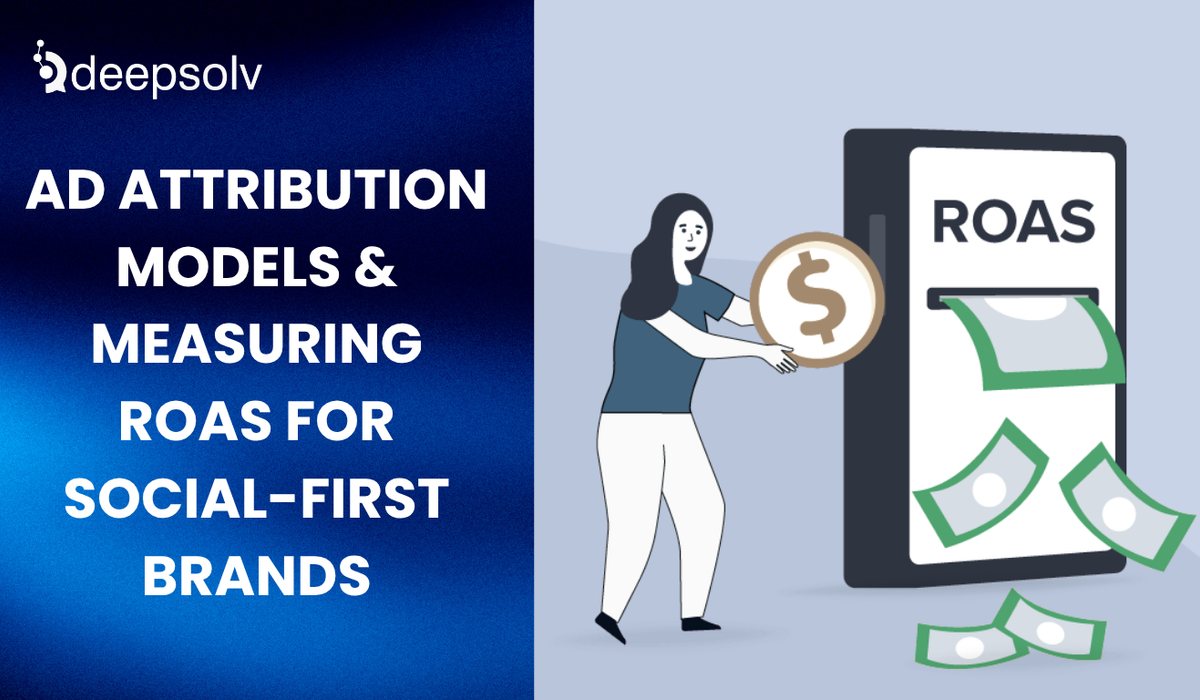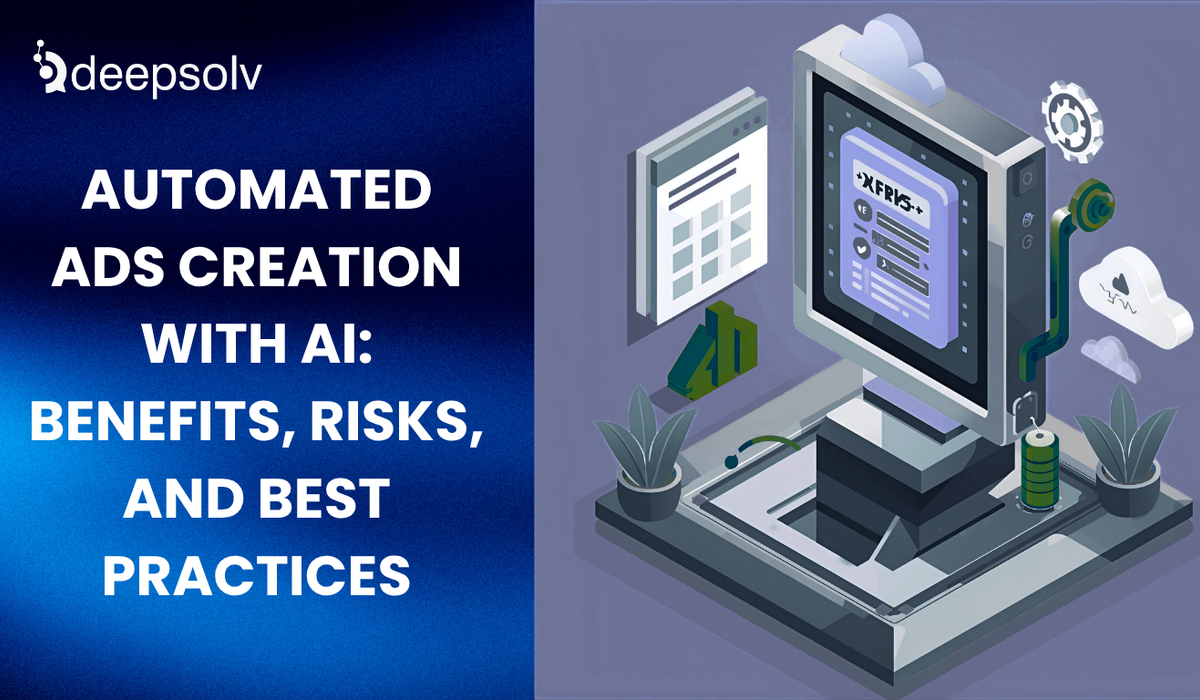Ad Attribution Models & Measuring ROAS for Social-First Brands
6 min read
Published: 10/9/2025

Introduction: The Truth Behind Your ROAS Lies
Every social-first brand loves a good ROAS screenshot.Your Meta Ads dashboard says 6.2x.Google Analytics says 2.1x.Shopify revenue doesn’t quite add up.
So… who’s right?
This is the modern marketer’s dilemma — in 2025, ad attribution and ROAS measurement have become both more powerful and more confusing than ever.
Between iOS privacy changes, AI-driven ad delivery, and cross-platform behavior, brands can’t rely on single-platform metrics anymore.
If you’re scaling a social-first brand — one that lives on Meta, Instagram, TikTok, or YouTube — you need a smarter way to attribute performance and measure what actually drives profit.
In this blog, we’ll break down:
- What attribution really means in 2025
- Which models work best for social-first brands
- How to measure true ROAS (not just what Meta says)
And how Deepsolv’s AI tools like Adam make cross-platform measurement automatic and accurate
Why Attribution Feels Broken (But Isn’t)
Here’s the real issue: your customer’s journey is no longer linear.
They see your TikTok ad, watch your Instagram Reel, search your brand name on Google, click a retargeting ad, and finally buy through email — all in 48 hours.
If you’re only crediting the last click, you’re missing the 4-5 earlier steps that actually created the sale.
That’s why so many brands mistakenly scale or kill campaigns based on misleading ROAS.
Attribution isn’t broken — it’s just outdated if you’re using old models like “last click” in a world where discovery happens on Reels, Shorts, and TikTok before intent ever hits Google.
What Exactly Is an Attribution Model?
An attribution model determines how credit for a sale or conversion is divided among the different ads, platforms, and touchpoints a user interacted with.
Imagine your customer sees:
- A TikTok video ad
- An Instagram carousel
- A Meta retargeting ad
- And finally clicks a Google search ad to purchase
Which ad gets credit? That’s what attribution modeling answers.
Here’s a breakdown of common models and how they work:
| Model | Description | Ideal For |
| Last Click | 100% credit goes to the final ad clicked. | Search-heavy funnels, lead gen. |
| First Click | 100% credit to the first ad seen or clicked. | Brand awareness or launch campaigns. |
| Linear | Equal credit to every touchpoint. | Long consideration journeys. |
| Time Decay | More credit to recent interactions. | Retargeting-heavy brands. |
| U-Shaped (Position-Based) | 40% to first + last, 20% split across middle touchpoints. | E-commerce & social-first brands. |
| Data-Driven Attribution (DDA) | Uses machine learning to assign proportional credit dynamically. | Mature brands with cross-platform spend. |
In 2025, Data-Driven Attribution (DDA) has become the gold standard because it reflects how people actually behave — hopping between platforms and touchpoints.
Why Social-First Brands Need a New ROAS Playbook
Social-first brands — think D2C fashion, skincare, supplements, and lifestyle products — don’t convert on the first click.
They convert through emotion, repetition, and trust-building over time.
That means your “cold ad” on Meta or TikTok might not drive a sale immediately, but it influences the eventual purchase days later.
When you only look at Meta’s “7-day click” ROAS, you’re undervaluing the awareness stage — and missing the compounding impact of discovery ads.
The New Rule for 2025:
“Attribution isn’t about credit, it’s about context.”
You need to measure how each platform contributes to the full journey — not which one gets the final click.
Why Platform ROAS Is Misleading
Every ad platform overclaims its impact.
Let’s say a customer interacts with both your Meta and Google ads before converting.
- Meta will count that sale under its 7-day click window.
- Google will also count it under its 30-day view window.
End result? Double-counting.
You might think your $20K spend made $100K, but in reality, your actual blended return is closer to $60K.
That’s why every serious brand in 2025 tracks blended ROAS — a holistic performance metric across all paid channels.
Blended ROAS: The Metric That Reveals the Truth
Formula:
Blended ROAS = Total Revenue ÷ Total Ad Spend (across all platforms)
This number cuts through inflated dashboards and shows you your true profitability.
If your total sales are $150,000 and your combined ad spend (Meta + TikTok + Google) is $37,500 — your blended ROAS = 4x.
It doesn’t matter if Meta claims 6x and TikTok claims 3x — blended is what the CFO cares about.
💡 Pro Tip: Pair blended ROAS with channel contribution analysis to see which platforms drive top-funnel awareness vs bottom-funnel conversions.
Top Attribution Models for Social-First Brands
1. Data-Driven Attribution (AI-Based)
Platforms like Meta, Google, and TikTok now use machine learning to assign value dynamically across touchpoints.
Example: If a user sees three Meta ads and one TikTok video before purchase, DDA might give Meta 70% credit and TikTok 30%, based on actual behavior patterns.
Why It Works:
- Accounts for multiple touchpoints
- Learns from conversion data
- Adjusts automatically as behavior changes
2. U-Shaped (Position-Based) Attribution
Gives equal importance to first and last interactions — which is perfect for social-first brands where awareness and retargeting matter equally.
Example: A customer sees a Reel (first touch), engages with a carousel (middle), and clicks a retargeting ad (last). U-shaped attribution gives: 40% credit to the first, 40% to the last, and 20% to the middle.
This model ensures your creative storytelling and retargeting both get recognized for their role in the sale.
3. Time Decay Attribution
This model gives more weight to the most recent ads before conversion.
Example: If a user saw five ads over a week, the ads from days 6–7 get higher credit.
It’s useful for brands running retargeting-heavy Meta or Instagram campaigns, where the final nudge matters most.
How to Measure True ROAS (Step-by-Step)
- Set Up Accurate Tracking
- Implement Meta’s CAPI (Conversions API) to capture server-side data.
- Sync your Shopify, Google Ads, and TikTok pixel data.
- Use Deepsolv’s Adam to unify tracking
- Define Attribution Windows
- Meta uses 7-day click / 1-day view
- Google defaults to 30-day click
- TikTok uses 7-day click / 1-day view Set consistent windows for fair comparison.
- Use a Unified Dashboard Aggregate spend, conversions, and revenue across platforms to track blended ROAS and campaign overlap.
- Measure Incrementality Run A/B tests with “holdout audiences” to see how sales change when ads are paused — this isolates true ad impact.
- Evaluate Creative Contribution Attribute performance not just by channel, but by ad type (Reel vs Carousel vs Video).
Real-World Brand Examples
1. Glossier – The Multi-Touch Masterclass
Glossier discovered that 70% of purchases came after multiple exposures across Meta and TikTok. After switching from last-click to data-driven attribution, they reallocated 20% of budget to awareness creatives — increasing blended ROAS by 34%.
2. Alo Yoga – Balancing Platforms
Alo Yoga used U-shaped attribution to understand which ads drove both discovery and conversion. Result: they realized top-of-funnel Instagram Reels contributed 41% more to final sales than previously assumed.
3. Deepsolv Client Case Study
A social-first lifestyle brand integrated Adam to unify Meta, TikTok, and Google data. The AI recalibrated attribution weights daily — identifying which creatives influenced conversions most. In 45 days:
- Blended ROAS improved from 3.2x → 4.8x
- Creative testing efficiency rose 27%
- Wasted spend dropped by 19%
That’s the power of AI-driven clarity — no more guessing, just scaling confidently.
How AI Is Redefining Attribution and ROAS in 2025
The old way: manually comparing dashboards. The new way: AI attribution orchestration.
Tools like Adam by Deepsolv pull data from every platform and assign credit intelligently, in real time.
They analyze:
- Which creatives drive first touches
- Which audiences deliver highest lifetime value
- How budget shifts affect multi-channel ROAS
Instead of lagging behind data, you get predictive insights — so you can act before inefficiency creeps in.
In short: AI doesn’t just measure ROAS; it helps you improve it.
Metrics That Complete the Picture
| Metric | What It Tells You |
| ROAS (Return on Ad Spend) | Efficiency of paid ads (Revenue ÷ Spend). |
| CAC (Customer Acquisition Cost) | Cost to acquire one customer. |
| MER (Marketing Efficiency Ratio) | Total revenue ÷ total marketing spend. |
| LTV (Lifetime Value) | Long-term revenue per customer. |
| Attribution Overlap Rate | How much credit platforms are double-counting. |
Monitoring these metrics together creates a holistic view of your brand’s health, beyond vanity dashboard numbers.
Conclusion: Measure Smarter, Scale Faster
In 2025, social-first brands don’t win by running more ads — they win by understanding what truly drives sales.
Attribution isn’t just about numbers — it’s about narrative. Each touchpoint tells part of the customer’s story, and the brands that track and optimize that story accurately will dominate.
By using blended ROAS, modern attribution models, and AI tools like Deepsolv’s Adam, you can finally connect creative, spend, and sales into one seamless system.
Stop fighting your data. Start mastering it — and scale with confidence.
⚡ Want to Know Your True ROAS?
👉 Book a free strategy session with Deepsolv. We’ll audit your ad performance across Meta, TikTok, and Google, identify attribution gaps, and help you use Adam to unlock your true blended ROAS.
⏳ Limited strategy slots this month — book before your next campaign goes live.
FAQs
Frequently asked questions related to this blog post


